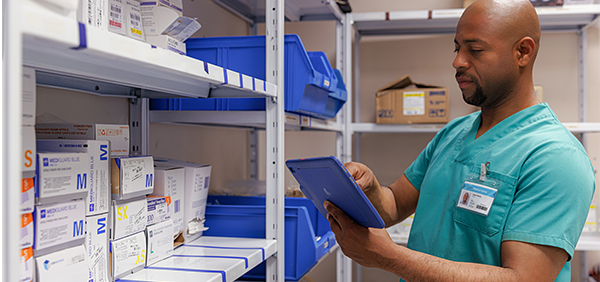How Involving Clinicians in Supply Chain Management Improves Patient Outcomes

In healthcare, it’s no secret that successful patient outcomes depend mainly on the nurses, lab techs and other frontline clinicians at the center of patient interactions. And it’s no mystery that positive results also depend on having the necessary supplies at the place and time they are needed.
What is a mystery, however, is why many hospitals, long-term care facilities, and ambulatory surgery centers fail to involve frontline staff in supply chain management fully. In fact, many healthcare organizations treat inventory management as an administrative task that’s largely separate from hour-to-hour, minute-to-minute clinical operations.
When results depend on what happens on the frontline, doesn’t it make sense to integrate supply chain management right into healthcare workflows?
The answer, of course, is an emphatic “Yes!” and is the topic of a recent healthcare webinar hosted by Barcodes, Inc., with featured guests from Zebra Technologies and Christus Health.
Step One: Involve Frontline Nurses and Clinicians in Inventory Management
When the COVID pandemic hit in March 2020, many healthcare organizations learned how resilient or fragile their supply chains actually were. COVID-related responses tested the entire healthcare system, with workforces strained to — or even beyond — their limits.
It’s safe to say that every healthcare organization dealt with inventory problems during COVID. And it wasn’t just PPD that was affected; just about every critical asset or inventory item was in short supply at one time or another. Organizations with good visibility into inventory on the frontlines had more flexibility to adapt, moving supplies where they most needed them and keeping on top of essential stocks. However, for organizations that did not have supply chain management integrated into frontline operations, every aspect of inventory management was an ongoing struggle, with patients and frontline staff bearing much of the burden.
For many healthcare leaders, this was a lesson in the importance of integrating supply chain management into the routine workflows of every clinician, especially the nurses and lab techs whose effectiveness depends on the availability of supplies.
There are two key takeaways here. First, it is critical to ensure frontline staff has the tools to access and update inventory information as a routine part of their activities without interrupting caregiving. Second, instead of relying on separate and manual inventory processes, inventory data needs to be captured and acted upon automatically in real time because nobody can make time to take inventory when staff is working double or triple shifts.
Step Two: Put Technology to Work
The good news is that the tools needed to integrate inventory processes and supply chain management into routine healthcare workflows are easily attainable. Just about everything necessary to gain real-time inventory visibility can be captured with the mobile devices already being deployed to improve clinician communication and collaboration.
The key is to ensure that mobile devices have data capture capabilities that can be integrated into existing ERP systems. With this capability, every time supplies are moved or used, the action is seamlessly recorded with a handheld mobile computer or tablet in real time.
Integrating inventory data capture links every process to inventory management. Suddenly, nurses and other clinicians become a routine part of supply chain management — without disrupting their usual workflows. The result is that frontline personnel can see what is available, and administrators receive the real-time information they need to make data-driven inventory decisions.
With this simple step, the need for manual inventory processes is significantly reduced, and supply chain management is greatly simplified — even automated. And, because fewer out-of-stock situations mean supplies are available when nurses and other clinicians need them, patients receive better care.
It’s even possible to use the same approach to streamline billing, capturing supplies usage in patient electronic medical records.
Barcodes and Christus Health
Barcodes, Inc. worked closely with Christus Health to deploy a range of Zebra mobile devices throughout their clinical operations. They chose Zebra devices because they’re specifically engineered for healthcare usage, with rugged materials that withstand frequent disinfection, and because they deliver proven barcode scanning tools that make it easy to integrate inventory management into healthcare workflows.
To learn more about how Zebra devices can streamline supply chain management, watch the replay of our webinar or contact your Barcodes, Inc. representative.
How the Healthcare Supply Chain Impacts the Patient Care Experience

Connecting the Dots: The Impact of Healthcare Supply Chain on the Patient Care Experience
Thursday, June 22, 2023
11:00 AM CT
Join us for an insightful webinar led by Zebra’s Chief Nursing Informatics Officer, Rikki Jennings, featuring leaders from CHRISTUS Health, Zebra, and Barcodes Inc.
This panel discussion will explore how an efficient and optimized supply chain can elevate the way patients receive care, ensuring improved outcomes and enhanced satisfaction.
Presented By:
Rikki Jennings, Zebra Technologies, CNIO
John Wirthlin, Zebra Technologies, Industry Principal
Steve Beno, Barcodes, Director of Healthcare Sales
Tim Tassone, Barcodes, Principal Solutions Architect
Featured Speakers:
Susan Pustka, RN, CHRISTUS Health, Director, Infor ERP Services – Technical
Curt Evans, CHRISTUS Health, Director, Infor ERP Services – Supply Chain Management
Key Discussion Points in the Webinar:
Our panel of healthcare supply chain technology experts will address these key topics:
- Importance of supply chain management and its impact on patient care
- Bridging the gap between supply chain and clinical care by involving nursing leadership in the discussion




